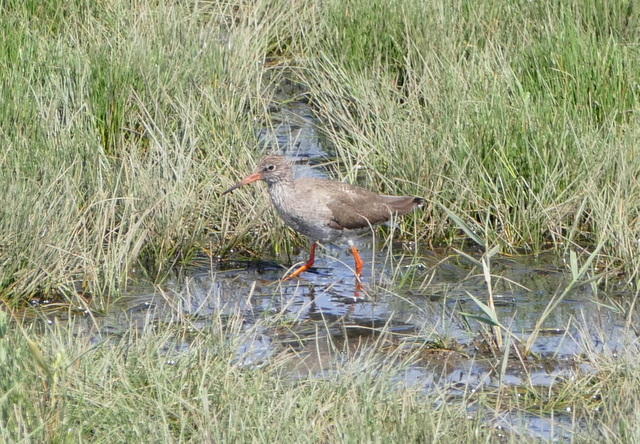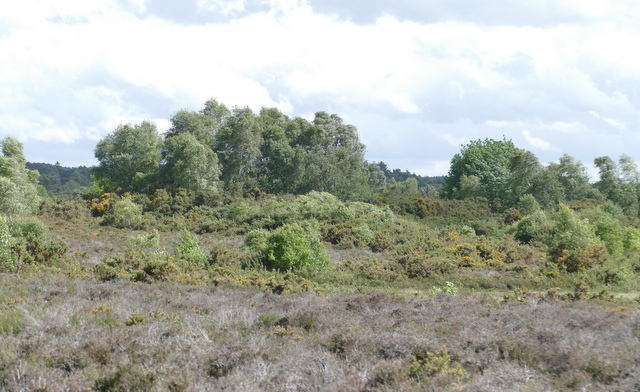The first of the Summer Tours today. It didn’t feel much like summer, despite the meteorologists telling us it was. It was overcast and blustery in the morning, but at least there was no sign of the originally forecast heavy rain. It did brighten up in the afternoon, but winds gusting at 50-60mph made the going rather difficult!
We started with a detour inland, to check out some of the local farmland specialties. There were still plenty of Skylarks singing, though they were not going as high into the sky as they would normally. We watched a wing-tagged Marsh Harrier quartering the fields, but it was too far away to read the code on the tags. A couple of Common Buzzards circled up as well.
Out in the fields, there were several Red-legged Partridges. There is no shortage of them here – very large quantities are released for shooting every year. But checking through the partridges finally yielded a pair of Grey Partridges, lurking on the edge of a grassy meadow. However, with the wind already whistling across the open fields, there was no sign of any Stone Curlews on our travels this morning. Presumably, they very sensibly had their heads down. We decided to move on.
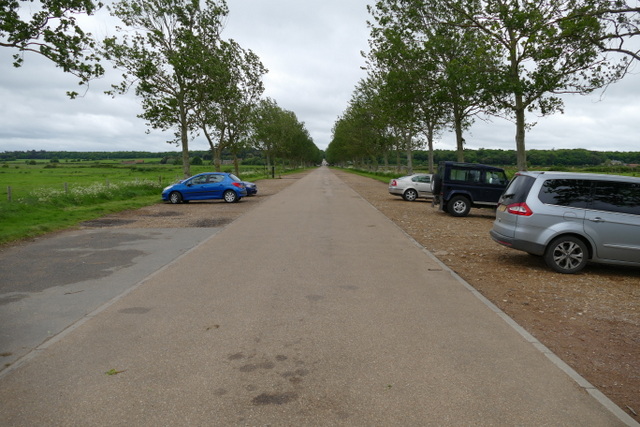 Lady Anne’s Drive – very quiet this morning
Lady Anne’s Drive – very quiet this morning
We drove down to Holkham. There were very few cars down at Lady Anne’s Drive, a big contrast to recent days, but no real surprise given the weather. We stopped on the way down the Drive to look at the pools – a half grown juvenile Lapwing dwarfed a very young Redshank chick, a ball of fluff on long legs. We walked west on the inland side of the pines. There were still a few warblers singing – a Blackcap, a couple of Chiffchaffs, and a half-hearted Whitethroat. We paused to watch a family party of Coal Tits feeding in the trees.
We diverted up past the Washington Hide and along the boardwalk to the beach. It was more sheltered on the north side of the pines and lots of Swifts were hawking for insects along the edge of the trees and skimming low over the dunes. Out over the sea, we could see a little flock of Common Scoter struggling to fly west and several Gannets were circling and plunge diving further east. Three Little Terns flew in over the beach, calling, and several Sandwich Terns were flying around over the shoreline.
We stopped in the Washington Hide on the way back. We were glad we did as a male Marsh Harrier put on a great display. He disappeared to our left and went to hunt over the grazing marsh, but kept coming back over the reeds in front of the hide and gave us a couple of really close fly-pasts. He was periodically pursued by one of the local Lapwings, but seemed pretty unconcerned.
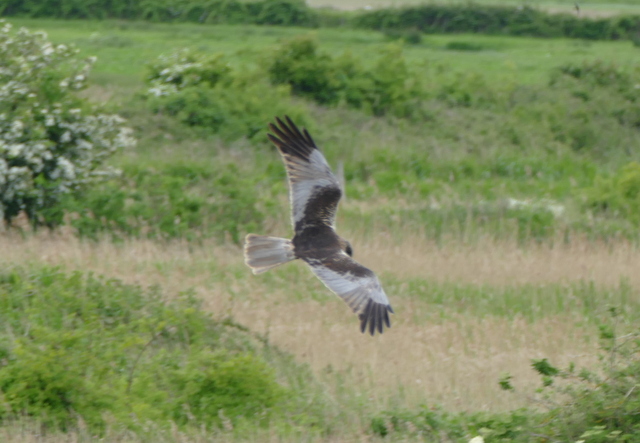 Marsh Harrier – this male put on a great display in front of Washington Hide
Marsh Harrier – this male put on a great display in front of Washington Hide
There were other birds to see there as well. The first of the day’s Spoonbills flew past, long neck outstretched, on its way from feeding further east back towards the colony. A Red Kite circled up over the trees on the edge of Holkham Park. And there were the usual breeding ducks, geese and waders to admire from here.
Continuing west, a Sparrowhawk flicked out of the pines above us. We stopped to watch a male Blackcap feeding in the shelter of Meals House garden and listen to a Cetti’s Warbler singing loudly. We could hear the odd Goldcrest and Treecreeper calling from the shelter of the pines and came across a big flock of Long-tailed Tits. While watching them, we had a frustrating glimpse of what was probably a Firecrest, but it disappeared into the trees before we could get onto it.
The view from Joe Jordan hide was a little quiet when we first sat down. There was no sign of anything white initially on the pool below the trees. However, after a short while the first Spoonbill flew down, a juvenile with a short ‘teaspoon’ bill. It was then joined by an adult Spoonbill and we got the two of them in the scope, comparing the body plumage colour (white on the juvenile, off-white on the adult), the nuchal crest and yellow bill tip of the adult lacking in the juvenile, as well as the obvious bill length difference. In the end, several birds came and went while we sat in the hide.
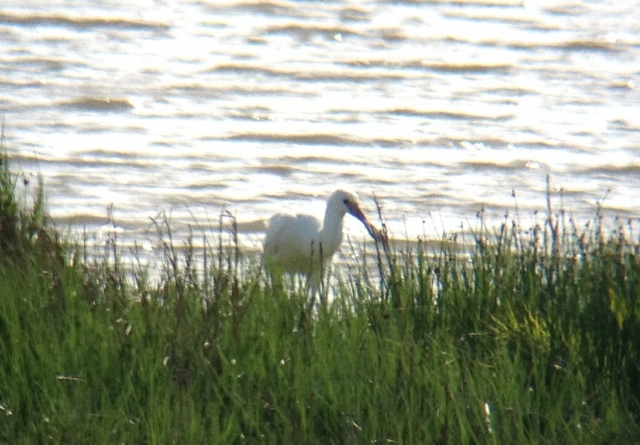 Spoonbill – a short-billed juvenile
Spoonbill – a short-billed juvenile
There were also lots of Little Egrets, Cormorants and a few Grey Herons coming and going. We got another smart male Marsh Harrier in the scope when it perched up on a post. A Yellow Wagtail flew past, but was only seen by one member of the group. And the usual pair of Grey Partridge were again feeding below the hide in the grass, giving us a great view.
 Grey Partridge – below the Joe Jordan hide again today
Grey Partridge – below the Joe Jordan hide again today
Non-avian interest was provided by the very smart Brown Hare which ran towards the hide. It stopped for a moment a suitable distance in front, posing for the paparazzi, then came right down to the grass below the hide to feed.
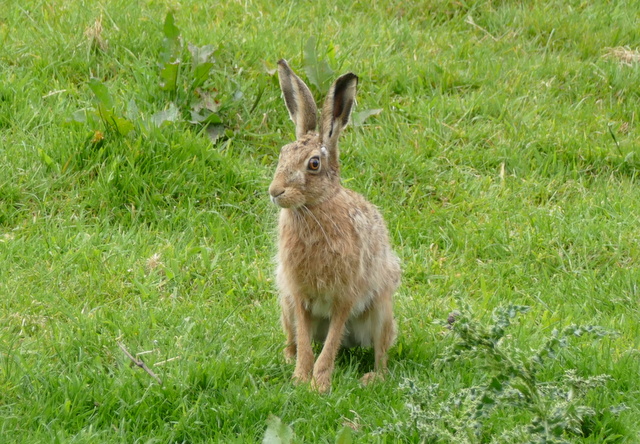 Brown Hare – posing for the camera
Brown Hare – posing for the camera
The rain had held off all morning, which was a nice surprise. We headed back to the car and drove along the coast towards Cley for lunch. We had to take a very quick detour on the way. During the morning, the telescope (and tripod) had blown over in the wind and the thread on the tripod mount had shredded. A couple of minutes at Cley Spy and they had it all fixed. Fantastic service, as usual!
We ate our lunch outside, on the picnic tables in front of the Visitor Centre at Cley Marshes. We were not expecting to be able to do that today! While we were eating, a large, golden brown bird flew across North Scrape, circling over the water before dropping down into the reeds – a Bittern. Another surprise for the day.
Afterwards, we headed out to the East Bank. It had been windy during the morning, but the wind picked up even more in the afternoon. Gusts of 30-40mph earlier on increased to close to 50mph. We were slightly sheltered walking along the path by the road, but once we got up onto the East Bank, we realised just how strongly the wind was blowing. It was hard to stand up at times.
There have been lots of birds in recent weeks on the Serpentine and Pope’s Pool, but it was quieter today. Perhaps they were seeking shelter out of the wind. Certainly the Little Egrets were in the channels and on the reedbed pools today, rather than being out in the open. We still got a good look at one through the scope, on the edge of the reeds. We could see it catching lots of small fish.
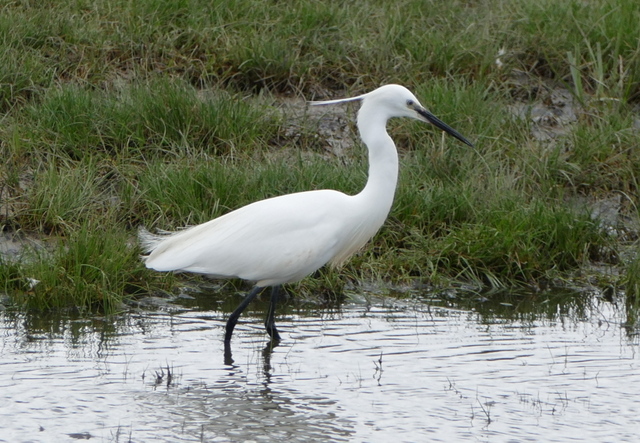 Little Egret – a recent picture, where they are normally on the grazing marsh
Little Egret – a recent picture, where they are normally on the grazing marsh
There were a few Redshank and Lapwing on the pools around the Serpentine. One of the latter seemed to take offense at two of the former and spent some time dive-bombing them. A quick scan with the (newly-repaired) scope revealed some distant smaller waders on Pope’s Pool – a single Tundra Ringed Plover with 5 Dunlin. From further up along the path, we could see that there were actually at least 12 Tundra Ringed Plovers, but they were sheltering in one corner. It was as much as we could do to stop the scope from blowing over again, so we couldn’t see if there was anything else lurking around the pools.
Arnold’s Marsh was quiet as well – and very windswept – apart from a single Turnstone and a couple of Sandwich Terns. We got the latter in the scope and got a good look at their shaggy black crests and yellow-tipped black bills. A Common Tern flew past as well, and then a Mediterranean Gull, a smart adult flashing its pure white wing-tips. We walked quickly to the sea and then headed back to try to get out of the wind.
It was hard birding on the coast in the wind, so we decided to head inland to try to get a little shelter. The Heath is still a bit exposed, and always better in calmer conditions, but seemed like a more attractive option at this stage. While we were up there, the wind increased even more, gusting to over 60mph at times. We had a look round, but apart from a few Linnets, most of the birds were keeping their heads well and truly down. We could hear a Willow Warbler singing from the birches. Then a smart male Stonechat appeared on a dead tree. As we watched it, we could see it was being pursued by 2-3 streaky juveniles. Unfortunately, there was no sign of the other heathland specialties today.
We had a good look round and then it was time to head back. Despite the wind and the best efforts of the weather, we had amassed a very respectable 78 species seen and heard during the day.
